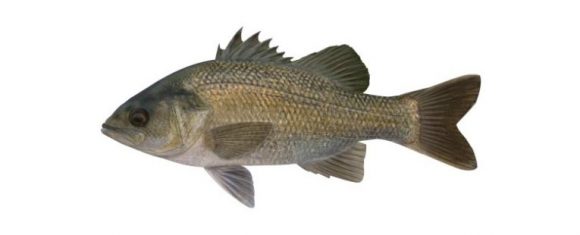Australian Bass

The Australian Bass – Macquaria novemaculeata – also known as the Australian perch, survives in wild populations in the rivers and estuaries of South East Queensland – from Fraser Island and the Mary River to tributaries of Gippsland Lakes in Victoria. It lives primarily in clear flowing streams and hangs in and around snags waiting to ambush its prey.
The Australian Bass is dark olive-grey-green on its back fading to an off-white or yellowish-white below. This fish has been recorded as large as 600mm and 3.8kg – but is more commonly seen at 300 – 400mm and weighing 1.2kg.
The Australian Bass is catadromous, migrating down-stream into estuaries to breed from May to August, before returning to freshwater. Spawning occurs is brackish waters (1/2 to 1/3 sea water) when the temperature is between 11 and 18 degrees Celsius.
This species is highly fecund, producing an average of a 500,000 eggs, with larger fish up to 1,500,000. They may spawn repeatedly in a season.
Stocking
Hatchery reared fingerlings were first stocked by the Department of Primary Industries (DPI) in 1988 and have since been introduced into most dams east of the Dividing Range from Lake Carnia, near Monto South.
Bass have been a great fish stocking success and are providing excellent returns to anglers. However the Australian Bass will not breed in Queensland dams, hence need to be consistently restocked. In the wild, artificial barriers such as barrages, weirs and dams have restricted the habitat that this species can reach and also reduced their ability to reproduce – resulting in a marked decline in comparison to their natural range.
The Australian Bass is a carnivore that feeds mainly on shrimp, insect, frogs and small fish. Seen as one of Australia’s premier freshwater sportfish, the Australian Bass supports and important recreational fishery in south-east Queensland and is growing in popularity in the stocked impoundments.
Angling
Angling techniques generally used involve luring with deep-diving minnows, surface poppers and spinner baits. Bait fishing is also productive using shrimp, crayfish, worms, grasshoppers, etc as bait. Fly fishing for this species has become extremely popular in recent times with the best catches made at dawn and dusk.
A great sporting fish and good eating, it is more often tagged and released rather than kept – due to its decline in numbers. The minimum size limit for the Australian Bass is currently 300mm with a bag limit of 2 fish per person.
Australian Bass can be caught all year in Lake Monduran. Closed season rules apply throughout Queensland – so it is important to check with the Department of Primary Industries & Fisheries for closure areas.
